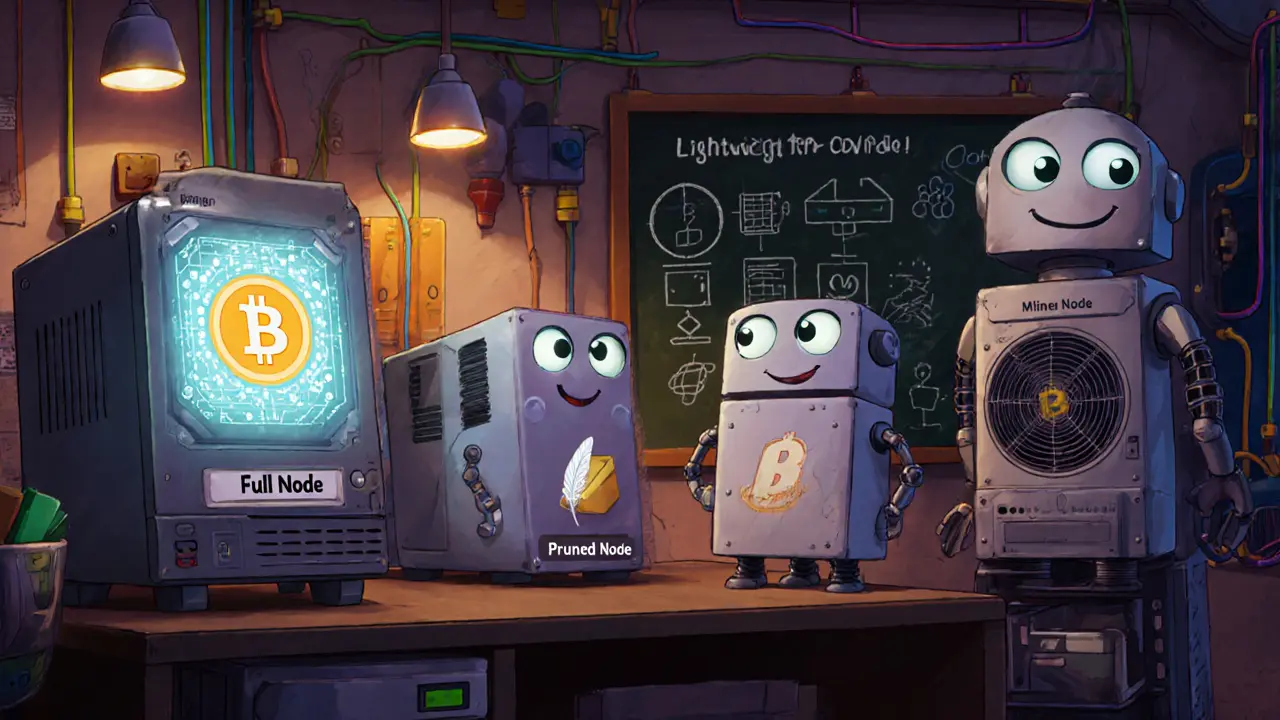Bitcoin Network Security Estimator
Bitcoin Network Security Estimator
Estimate how many Bitcoin nodes provide secure, decentralized network protection
Network Security Level
With 24,000 nodes, the Bitcoin network has moderate security.
The current node count is close to the threshold for strong security but still has some vulnerability.
Each node independently enforces consensus rules. More nodes mean higher resistance to censorship and attacks. The article shows that node count is a key indicator of network health. Note that 64.6% of nodes are hidden using Tor/VPN, which enhances privacy but makes geographic analysis difficult.
Ever wondered exactly how many computers are keeping Bitcoin alive right now? As of October 2025 the network runs around 24,000 Bitcoin nodes, and that number isn’t just a trivia fact-it’s the backbone of the system’s security and decentralisation.
Bitcoin nodes are computers that run Bitcoin software, store a copy of the blockchain, and talk to each other over port 8333. They verify every transaction, relay new blocks, and enforce the consensus rules that prevent double‑spending. In short, without these nodes the public ledger would collapse into a single‑point‑of‑failure mess.
Current Node Landscape
Two major explorers track reachable nodes: Bitnodes.io lists 24,266 reachable nodes on October 1 2025, while Coin.dance reports 24,119 public nodes, of which 19,049 run the reference implementation, Bitcoin Core. The network spans 102 countries, but a striking 64.6 % of nodes appear as “n/a,” indicating use of Tor or VPNs to hide their location.
Geographic hotspots (identifiable): United States - 2,440 nodes (10.06 %), Germany - 1,319 nodes (5.44 %), France - 698 nodes (2.88 %), Canada - 412 nodes (1.70 %), Finland - 398 nodes (1.64 %). These numbers show a global presence but also a concentration in a few developed regions.
What Types of Nodes Exist?
Full node stores the entire blockchain (about 500 GB in 2025) and validates every incoming transaction and block against the consensus rules.
Lightweight node (or SPV node) downloads only block headers and relies on full nodes for proof that transactions are valid.
Miner node creates new blocks, packages transactions, and competes to win the block reward through proof‑of‑work.
Pruned node keeps only the most recent part of the blockchain, discarding older data to stay under a few hundred gigabytes of storage.
Bitcoin Core is the reference client that most nodes run. As of 2025, version 29.0.0 leads with 2,571 nodes, followed by 26.0.0 (2,120 nodes) and a hybrid 28.1.0/Knots build (1,899 nodes).
Tor (the .onion network) lets operators hide their IP address; .onion nodes grew 3 % in the last quarter.
Node Count vs. Network Security
The more independent copies of the blockchain exist, the higher the cost for an attacker to rewrite history. Each full node holds the entire ledger, so compromising the network would require controlling a majority of the computing power *and* a majority of the honest nodes that enforce the protocol. In practice, the distributed nature across 24 k+ nodes means any coordinated attack faces astronomical resource requirements.
Researchers at CoinShares note that node decentralisation is the primary defence against censorship. If a single ISP or government shuts down a regional cluster, the rest of the world still propagates transactions. The 64.6 % of “unidentified” nodes-likely behind Tor-act as a privacy buffer, ensuring that even if some jurisdictions tighten regulations, the network stays alive.

Growth Trends and Technical Challenges
- IPv4 nodes up 7.5 % YoY, IPv6 up 14.2 %-reflects migration to newer internet stacks.
- Blockchain size reached 673.58 GB by September 2025, growing roughly 1 GB every few days.
- Storage cost per GB has fallen to $0.03, making full‑node operation more affordable than a decade ago, yet the sheer size still deters casual participants.
- Pruned nodes and lightweight clients lower the entry barrier, keeping the ecosystem inclusive.
Node Types Side‑by‑Side
| Node Type | Typical Storage | Bandwidth Needs | Main Role | Common Software |
|---|---|---|---|---|
| Full Node | ≈ 500 GB (full blockchain) | ≈ 200 Mbps upstream | Validate & relay all transactions | Bitcoin Core |
| Pruned Node | ≈ 30 GB (recent blocks only) | ≈ 150 Mbps upstream | Validate recent blocks, reduce storage | Bitcoin Core -prune flag |
| Lightweight (SPV) Node | ≈ 1‑2 GB (headers only) | ≈ 50 Mbps upstream | Send/receive payments, rely on full nodes for verification | Electrum, Wasabi |
| Miner Node | ≈ 500 GB + mining hardware | ≈ 250 Mbps upstream | Create & propose new blocks | Bitcoin Core + mining software |
Why You Might Want to Run a Node
- Privacy: Directly verify transactions instead of trusting third‑party wallets.
- Security: Help protect the network by adding another honest copy of the ledger.
- Community support: Contribute to the decentralised ethos that makes Bitcoin censorship‑resistant.
- Learning: Gain hands‑on experience with blockchain data structures and P2P networking.
For hobbyists, a pruned node on a cheap SSD can be set up in under an hour. Enterprises often run multiple full nodes behind load balancers to avoid reliance on third‑party APIs.

Potential Risks of a Declining Node Count
If the node ecosystem shrinks, two main dangers emerge:
- Centralisation of validation: Fewer honest nodes mean a malicious actor could more easily influence consensus.
- Increased censorship: Governments could target the remaining nodes, forcing users onto centralized services that can be blocked.
Monitoring the node count therefore acts as an early warning signal for the health of the entire Bitcoin ecosystem.
How to Verify the Latest Node Count
Visit these two reliable explorers:
- Bitnodes.io - real‑time map and daily snapshots.
- Coin.dance - detailed breakdown by client version and geography.
Both sites publish CSV downloads you can mash into a spreadsheet for deeper analysis.
Future Outlook
As storage costs keep falling and IPv6 adoption expands, the barrier to running a full node will likely dip below the $50‑per‑year mark. Meanwhile, protocol upgrades such as assumeutxo and compact block relay could shave off gigabytes of data per day, easing bandwidth pressure. The community’s push for “node‑friendly” upgrades signals a strong commitment to keeping the count high.
How many Bitcoin nodes are there right now?
As of early October 2025, roughly 24,000‑plus reachable nodes are active, with Bitnodes.io reporting 24,266 and Coin.dance showing 24,119 public nodes.
What’s the difference between a full node and a pruned node?
A full node stores the entire blockchain (≈ 500 GB) and can validate any historic transaction. A pruned node discards old blocks, keeping only the most recent data (≈ 30 GB), which reduces storage needs while still validating new blocks.
Why does node distribution matter for security?
Each node independently enforces the consensus rules. The more geographically and administratively diverse nodes there are, the harder it becomes for an attacker to control enough of them to rewrite history or censor transactions.
Can I run a Bitcoin node on a home internet connection?
Yes. A pruned node needs about 30 GB of storage and a stable broadband line (≈ 150 Mbps upload). Many hobbyists run such nodes on a Raspberry Pi with an external SSD.
How can I check if my node is correctly syncing?
Run bitcoin-cli getblockchaininfo. The blocks field should match the current block height (around 833,000 in 2025) and verificationprogress should be close to 1.0.
Stephen Rees
October 22, 2025 AT 03:34Ever look at the node maps and wonder who's really pulling the strings? The sheer number of hidden relays feels like a veil over a deeper network, maybe even state‑run. It's as if every node could be a listening post, quietly cataloguing transactions for an unseen agenda. And the surge in Tor‑based nodes? That's a clue, not just a privacy feature. The decentralisation narrative is comforting, but comfort can be a straight‑jack if the observers are too many.
Scott McCalman
October 25, 2025 AT 01:00Whoa, this post just blew my mind!!! 😱 The numbers are insane, 24k nodes?! That's like a whole city of computers humming away! And those stats about IPv6? Mind‑blowing! 🌐 The future is looking shiny, folks, keep those nodes running!!
johnny garcia
October 27, 2025 AT 22:27Insofar as the current nodes enumerate towards twenty‑four thousand, one must acknowledge the profound implication for systemic robustness. The proliferation of IPv6‑compatible peers indeed reflects a maturation of the underlying protocol stack. 📊 Moreover, the distribution across jurisdictions augments resistance to singular regulatory pressures. 🧐
Andrew Smith
October 30, 2025 AT 19:54Great stats, guys! This shows the community’s strength and we should keep championing node operation. If more people run even pruned nodes, the network gets tougher and more inclusive. Let’s spread the word and get fresh eyes on the blockchain!
Ryan Comers
November 2, 2025 AT 17:20Another day, another statistic trying to convince you the system is safe. 🇺🇸 Sure, 24k sounds big, but remember: a handful of powerful entities can still dominate if they control the mining pools. Don't be lulled into complacency, stay vigilant! 🚀
Prerna Sahrawat
November 5, 2025 AT 14:47One cannot help but marvel at the sheer magnitude of the Bitcoin node ecosystem as chronicled in this exhaustive treatise. The author deftly delineates the stratification of node typologies, from the prodigious full node to the nimble lightweight variant, each serving a purpose within the grand tapestry of decentralisation. Indeed, the geographic dispersion, albeit skewed towards affluent nations, betrays a lingering centralisation of infrastructural capability, a subtle reminder of the socio‑economic contours that shape adoption. The cited statistics on IPv6 expansion are particularly salient, heralding a forthcoming era wherein the network's resiliency is buttressed by modern protocol stacks, thereby mitigating legacy bottlenecks associated with IPv4 exhaustion. Moreover, the relentless increase in blockchain size, now surpassing six hundred gigabytes, underscores an inexorable march towards data abundance, yet simultaneously imposes a formidable barrier to entry for the casual enthusiast. It is precisely here that pruned nodes-exhibiting a modest thirty‑gigabyte footprint-emerge as a pragmatic compromise, preserving validation fidelity whilst eschewing the onerous storage demands of their full‑node counterparts. The proliferation of Tor‑enabled nodes, constituting close to two‑thirds of the observable populace, constitutes a veritable bulwark against state‑sanctioned censorship, a testament to the community's acumen in safeguarding privacy. One must also applaud the author's foresight in chronicling upcoming protocol optimisations, such as assumeUTXO and compact block relay, which promise to alleviate both bandwidth and storage strains, thereby democratizing participation. In summation, while the quantitative metrics are indeed impressive, it is the qualitative evolution-manifested in technological refinement, privacy‑centric architectures, and community‑driven outreach-that truly fortifies the Bitcoin network against prospective adversities.
Joy Garcia
November 8, 2025 AT 12:14Look, the numbers are staggering, but let’s not forget the moral weight behind every node. Each honest operator is a beacon against the darkness of corporate control. If we let that flame die, we’re complicit in the very oppression we claim to resist. Keep those boxes humming – it’s a righteous act.
Erik Shear
November 11, 2025 AT 09:40Nodes matter. More peers = stronger network. Run one if you can.
Jon Miller
November 14, 2025 AT 07:07Yo, this is sick! 🎉 The stats are legit and it’s awesome to see the community growing. Let’s keep the hype alive and get more folks to spin up a node, even if it’s just a lightweight one.